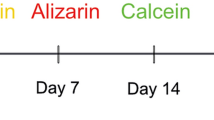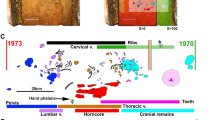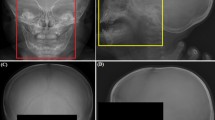Abstract
The Keilor Skull. The application of the fluorinephosphate method described by Oakley and Hoskins1 for determining the relative ages of fossils has shown that the Keilor Skull from near Melbourne is a true fossil, and its age that of the terrace in which it was found. The ratio  for the skull is 2.0, and of other fossils found in situ in the terrace 1.9, 1.5 and 2.9. Different parts of a rat skeleton gave 3.8 and 4.4—higher than anticipated, and due to low percentage of phosphate. I am indebted to Mr. W. R. Jewell, chief chemist, State Laboratories, Melbourne, and his staff for carrying out the analyses.
for the skull is 2.0, and of other fossils found in situ in the terrace 1.9, 1.5 and 2.9. Different parts of a rat skeleton gave 3.8 and 4.4—higher than anticipated, and due to low percentage of phosphate. I am indebted to Mr. W. R. Jewell, chief chemist, State Laboratories, Melbourne, and his staff for carrying out the analyses.
This is a preview of subscription content, access via your institution
Access options
Subscribe to this journal
Receive 51 print issues and online access
$199.00 per year
only $3.90 per issue
Buy this article
- Purchase on SpringerLink
- Instant access to full article PDF
Prices may be subject to local taxes which are calculated during checkout
Similar content being viewed by others
References
Oakley, K. P., and Hoskins, C. R., Nature, 165, 379 (1950).
Keble, R. A., and Macpherson, J. H., Mem. Nat. Mus. Melb., 14, (2), 52 (1946).
Mahony, D. J., Mem. Nat. Mus. Melb., 13, 7 (1943).
Raven, H. C., and Gregory, W. K., Amer. Mus. Novit., 1309 (1946).
Gill, E. D., Aust. J. Sci., 15 (2), 47 (1952).
Author information
Authors and Affiliations
Rights and permissions
About this article
Cite this article
GILL, E. Fluorine Tests in Australia on the Keilor Skull and a Tertiary Marsupial. Nature 172, 409–410 (1953). https://doi.org/10.1038/172409b0
Issue date:
DOI: https://doi.org/10.1038/172409b0



